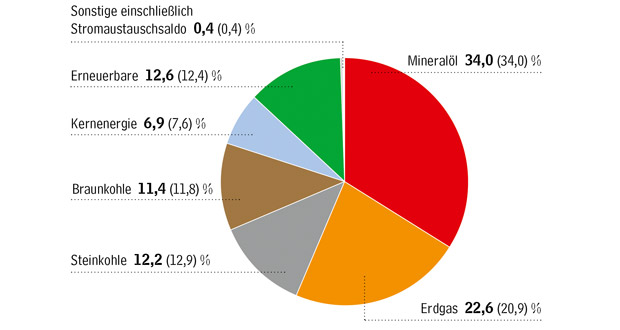In 2016, energy consumption in Germany reached 13,383 PJ or 456.7 mtce. This corresponds to an increase of 1.1 % compared to the previous year. In its current report on energy consumption in Germany in 2016, the German Working Group on Energy Balances (AGEB) attributed this increase to the influence of colder weather than the previous year, the leap year day, the consistently positive economic development and the growing population. It also claimed that the increase in consumption was dampened by further improvements in energy efficiency. Increases in consumption were observed in natural gas, mineral oil and renewable energy, while nuclear energy, hard coal and lignite all saw a decrease in consumption. Without the influence of the weather, the energy consumption would only have increased by approximately 0.6 %.
According to the AGEB, energy-related CO2 emissions increased by 0.7 %, and therefore by a considerably lesser margin than the energy consumption. The reduction in emissions due to the decrease in consumption of hard coal and lignite was more than compensated by the higher consumption of natural gas and mineral oil. Adjusted to take the influence of weather and the leap year into account, the increase in CO2 emissions was just 0.3 %.
Mineral oil consumption in 2016 was higher than the previous year, with an increase of 1.5 %. The total consumption was 4,550 PJ or 155.3 mtce. A particular contributing factor to this trend was the 4 % increase in the consumption of diesel fuel. Sales of aviation fuel were also higher than the previous year, with an increase of over 6 %. In contrast, the sales of petrol remained virtually unchanged, while those for light and heavy heating oil dropped by 2 % or 1 % respectively. The supply of raw petrol to the chemical industry showed an increase.
The consumption of natural gas rose significantly by 9.5 % to 3,022 PJ or 103.1 mtce. This increase in consumption was attributed to the colder weather compared to 2015 – particularly in the final quarter of the year – and the increased use of natural gas in power stations, particularly in combined heat and power plants. New gas power stations were also put into operation.
There was a slight decline in the use of coal by 5.1 % to 1,630 PJ or 55.6 mtce. The use of coal in power stations for the generation of heat and power dropped by 5.2 %. The use of coke and coal in the German steel industry fell by 4.9 %. Roughly two thirds of the total amount of coal consumed in Germany is used to generate electricity. The use of hard coal in power stations was influenced by the increased generation of electricity from natural gas and the increased supply of electricity from offshore wind energy plants.
The consumption of lignite fell by 2.8 % and reached a value of 1,522 PJ or 51.9 mtce. Around 90 % of lignite production was used in power stations to generate electricity and heat. Electricity generation from lignite decreased by a similar percentage as a result of lower power station availability.
Nuclear energy saw a decline of 7.8 % compared to the previous year, which can be attributed to several scheduled power station renovations and the decommissioning of the nuclear power station in Grafenrheinfeld in the middle of 2015.
The contribution made by renewable energy sources to the energy balance rose by almost 2.8 % overall to 1,689 PJ or 57.6 mtce. Biomass saw an increase of 3.9 %. The generation of electricity from hydroelectric power – without pumped-storage reservoirs – increased by almost 11 %, while on-shore and off-shore wind power saw a drop of 2.3 %. The contribution of solar energy – photovoltaic and solar thermal energy – decreased by 1.2 %.
The structure of energy consumption (energy mix) in Germany continues to be dominated by mineral oil (34 %). Due to the growth in natural gas, this now accounts for 23 % of consumption. Coal accounts for a share of 12 % and lignite for approximately 11 %. The renewable energy share increased slightly to 12.6 %. Overall, German energy supply is based on a broad range of energy sources (Figure 1). The export surplus in foreign electricity trading increased significantly in 2016, as unplanned losses of French electricity generation were compensated by imports from Germany.
In 2016, domestic power generation fell by 2.8 % to 3,978 PJ or 135.2 mtce. While the renewable energy sources continued to increase their contribution to domestic energy production, coal and natural gas production in Germany decreased. More than 80 % of domestic power generation is from renewable energy sources and lignite. Overall, domestic energy production covered almost 30 % of the total consumption in the past year.
The annual report from AGEB also provides precise data on consumption trends, detailed information about temperature-adjusted consumption, energy efficiency, import shares, domestic production, price trends and an initial estimate of energy-related CO2 emissions. The detailed report on the development of primary energy consumption in 2016 is now available to download from the AGEB website (www.ag-energiebilanzen.de).
(AGEB)/Si.)
